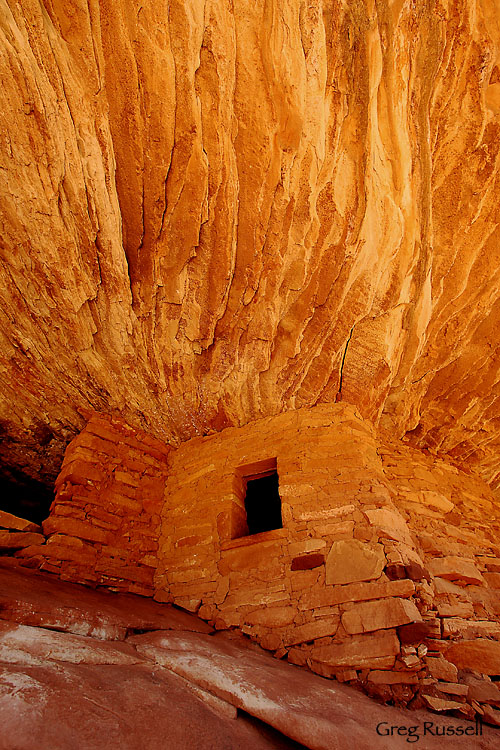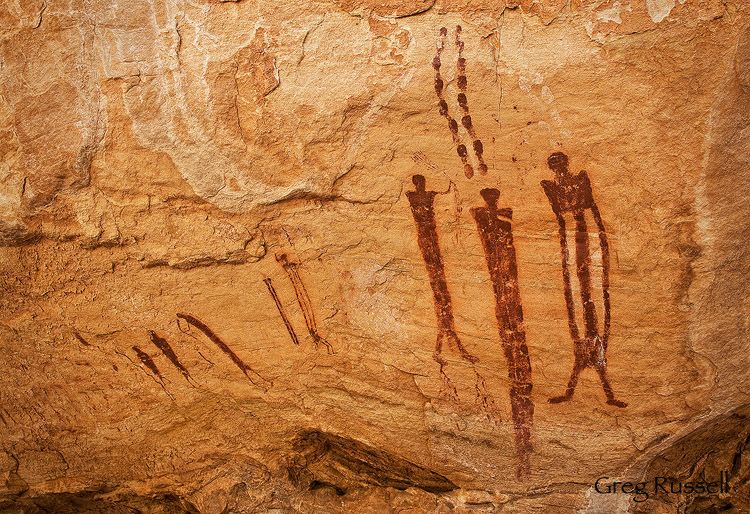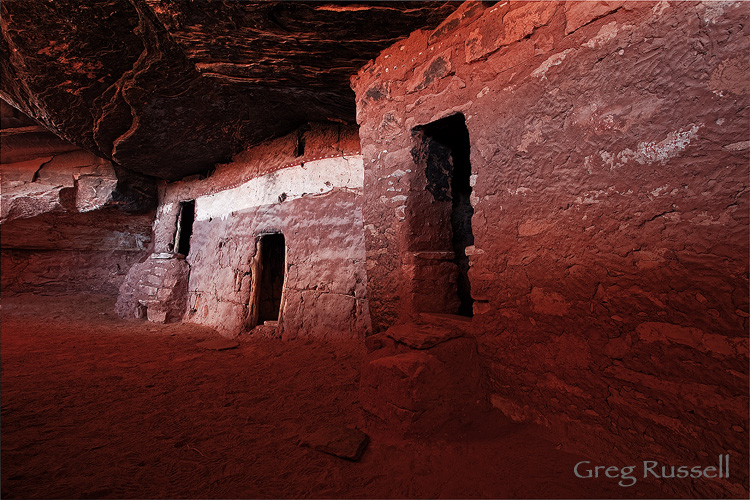Almost two years ago, Kah Kit Yoong published two blog posts on, “Art Appreciation in the Digital Age,” and, “Photographing Art and Museums,” that have been poignant enough to stick in my mind all this time for a couple of reasons. First of all, he raises big picture questions in my mind like, “Why are we so drawn to art?” or “Why do photographers feel driven to make art from art?” However, I find it curious that even though a dusty canyon in the Southwest might feel like it’s a world away from the Louvre or the Met, in some ways it is closer than we think.
Photography of Native American rock art and architecture seems to be a niche that landscape photographers fill somewhat naturally. Perhaps it is because we are already in the field, and taking a photograph of a pictograph panel or ancient dwelling adds a nice element to the image. Or, maybe the reason is deeper. Maybe we can relate to the original artist’s feeling of connectedness to the landscape, allowing our imaginations to wander, trying to imagine what this canyon might have looked like 800 or 1,000 years ago.
I have written before about my early years in the outdoors, backpacking in the Cedar Mesa area, which is one of the most archaeologically-rich areas in the world. A Bureau of Land Management archaeologist once told me that there is an estimated 2,000 sites per square mile on Cedar Mesa and in the Grand Gulch drainage in southeastern Utah. Granted, my idea of a “site” is quite different from an archaeologist’s but there is no arguing that is an impressive number. When I was young I enjoyed pretending that I was the first person to discover these sites since the original tenants left. Today, I enjoy visiting because there is a peacefulness in these places; I feel humbled and placed when I visit them. My youthfulness still lives on, however, as I enjoy the “treasure hunt” involved with looking for a particular rock art panel or ruin.
Regardless of why they are photographed, there are some archaeological sites in the Southwest that are becoming part of the landscape photographer’s repertoire, such as the “House on Fire” ruin in southeastern Utah. If you don’t know it by name, you have surely seen an image of it (you have now, anyway). And for good reason–it’s very photogenic. Others are less well known, but with some research, can be found online or in guidebooks fairly easily. Still other sites are–quite honestly–damned hard to find.
As the interest in these places continues to grow, it brings up some ethical questions, especially regarding those locations that are difficult to find. For instance, how much information should a photographer share about the location of a site (see here and here for great discussions on this subject)? Much unlike the Mona Lisa, these works of art do not have the protections that would keep vandals, or even an ignorant visitor capable of unintentional damage, out.
Would we want those protections in place?
Being able to photograph and experience these sites untethered is one of the joys of visiting them. Even if a simple cord or chain were to form an artificial boundary, there is no one preventing a breach of that line. In some ways, it seems that keeping quiet about specific locations of these sites is the best way to protect them.
In the former of the two blog posts mentioned at the beginning of this post, Kah Kit Yoong says, “Now I’m aware that tourists are just enjoying themselves and it’s not hurting anyone. Nevertheless it is annoying to see masterpieces relegated to props for snapshots.” I agree. While part of me feels it’s important to appreciate our cultural history, the rest of me hates to see a ruin go unappreciated, or be part of a photographer’s Southwestern image harvest, with no real knowledge of the site.
I hope this doesn’t read like an elitist rant about visiting archaeological sites; I am by no means pulling the ladder up behind me saying that no one else can “come play” in these places. What I am suggesting is that photographers think about the value of an archaeological site to themselves, to science, as well as to the descendants of the people who once lived there. On my website, I purposely don’t give much information on the sites I have images of, but am always happy to talk one-on-one with other interested people about these places.
Whether you’re in the Louvre, the Musee Rodin, or the Colorado Plateau, works of art surround you. Do you think they all deserve the same respect and protection? Why do you think we enjoy visiting these places so much?




I’ve always felt the same sense of awe when visiting these sacred places Greg.
Like you, I want to share the visual mystery that surrounds them through my images, but at the same time leave their locations as much a mystery for their presevation.
Thanks as always Russ for contributing to the conversation. I know you’ve got some great memories in these places as well…
Greg, my connection to sites like these, and especially to indigenous artwork, is really a pine for simpler times when environmental issues didn’t exist – at least as compared to those we face in the present. I often envision places I visit as they once were, and find that I wish they still could be that for no greater reason than my desire to live on a healthy planet, and to be part of a collective conscience that treats nature, the environment, etc., with respect.
Thanks, Wesley! I think that’s an honorable wish…I’m glad you find some solace in these places too…
All beautiful shots Greg! The preservation issues are significant, but what really bugs me about the publicization of archeological sites is the damage to the sense of discovery. Some more accessible sites are one thing, and public education and engagement are very worthwhile things. But for remote sites like the Cedar Mesa canyons, it’s a shame to see the whittling away of non-guidebooked territory. I know I’m free not to look, but knowing the info is out there really changes the mental landscape. I looked for a few seasons for the ruin in your third shot, navigating just by intuition and a friend’s fuzzy memories. I found some very neat sites in that process, but not that one. And it’s now a permitted site: though that’s surely a good and necessary decision by the BLM, it removes and chance of spontaneous discovery for this ruin. “The wood has been made into a boat,” as the Chinese put it, and I don’t pretend there’s any going back.
As far as photography goes, I just hope that my work adds to rather than subtracts from the sense of undiscovered country in the world. Concealing names in photo captions becomes somewhat futile if the locations have achieved a fair bit of notoriety, but for many places I still think it’s worthwhile to be vague.
As always, really well said, Jackson. I can definitely relate to your sentiments. The third shot was one I first caught a brief reference to in a book, and knew in that instant that I wanted to visit. However, once I started searching for hints as to its location, I found out about the permit system. During our visit we had the place to ourselves, which was nice, but I hear you in terms of the thrill of discovery.
In a similar vein, my dad and I (mostly my dad) have been searching for a (non-archaeological) site in New Mexico for the last few years, mostly going by a few fuzzy memories, and a lot of searching. I think this is a much more rewarding endeavor.
I suppose in some ways, this blog post sort of is self-defeating in terms of not publicizing these sites.
Sadly, I don’t think there’s much discovering left on Cedar Mesa–pothunters have made most of the discoveries for us. That’s a subject for another blog post…
Jackson Frishman is exactly right. The key word is “discovery,” and as E.O. Wilson put it: there is no greater high than discovery.
Though it may not be obvious to a casual visitor, the experience of discovering something through hard work and dedication (and/or luck) is vastly different from the experience of arriving at a predictable place by following directions.
The issue, to me, is not just protecting the sites themselves, but also protecting their mystery and the ability of future explorers to experience the magic and awe of discovering them anew.
Guy
Thanks for your thoughtful comment, Guy; I agree completely. Although I didn’t mention it much here, there is a huge thrill in searching for something new–even if it’s only new to you.
I think, going into the future, protecting the experience will be just as important as protecting the place.
Thoughtful post, as always. I think one reason we’re so torn about this is that by our very nature, we photographers want to share what we experience. And the conflict comes from our just-as-strong desire to protect these fragile places we love so much.
I’m very torn about the whole issue of whether to share a location. If it’s someone I know and feel relatively sure is someone who’ll treat the location with caution and respect, I’ll most likely give them the info they need to find it (and there are some places that are so difficult to get to, they have a kind of built-in protection).
If it’s something like House on Fire, there’s already so much info online about its location that it’s pretty pointless to be secretive about it. I would really hate to see barriers and chains put up around these treasures, so I hope they’re not so threatened that that becomes necessary. I suppose the best we can do is make sure any image sharing we do is also accompanied by a plea to protect and respect these locations.
Well said, Robin…you’re completely right! There is a conflict, and personally that conflict goes a bit deeper when thinking about archaeological sites; it’s one thing for someone to copy my image, but it’s another for someone to go there and destroy the place.
I think, as Guy notes above, saving as much of the experience for someone else is a validating enough reason to withhold info on a site, if you’re feeling so inclined…
With all the copycatting going on these days, why would anyone want to disclose their photo locations, UNLESS, they didn’t really care that much about their photography and were actually making their living from e-books, apps and photo tours rather than photography?
Generally the location isn’t all that important anyway…it *should* be about the creativity and awe of the natural world.
Thanks for the comment, David!